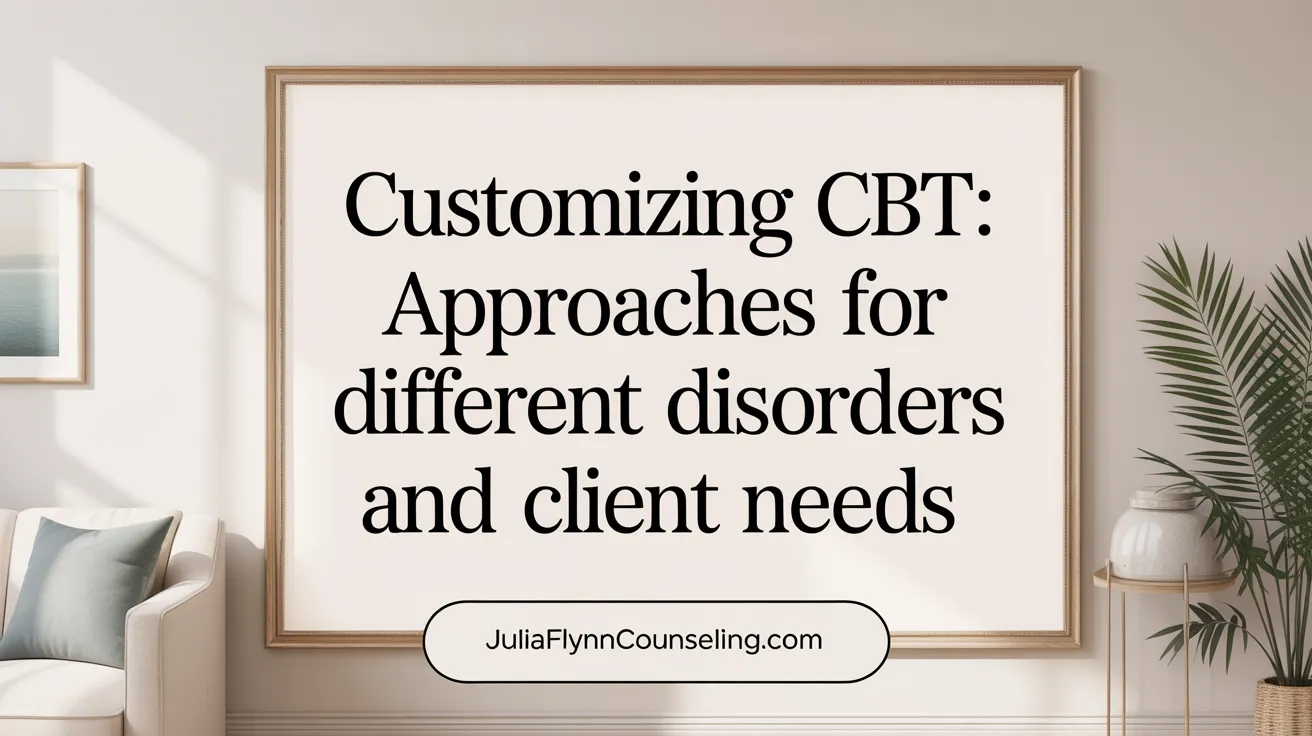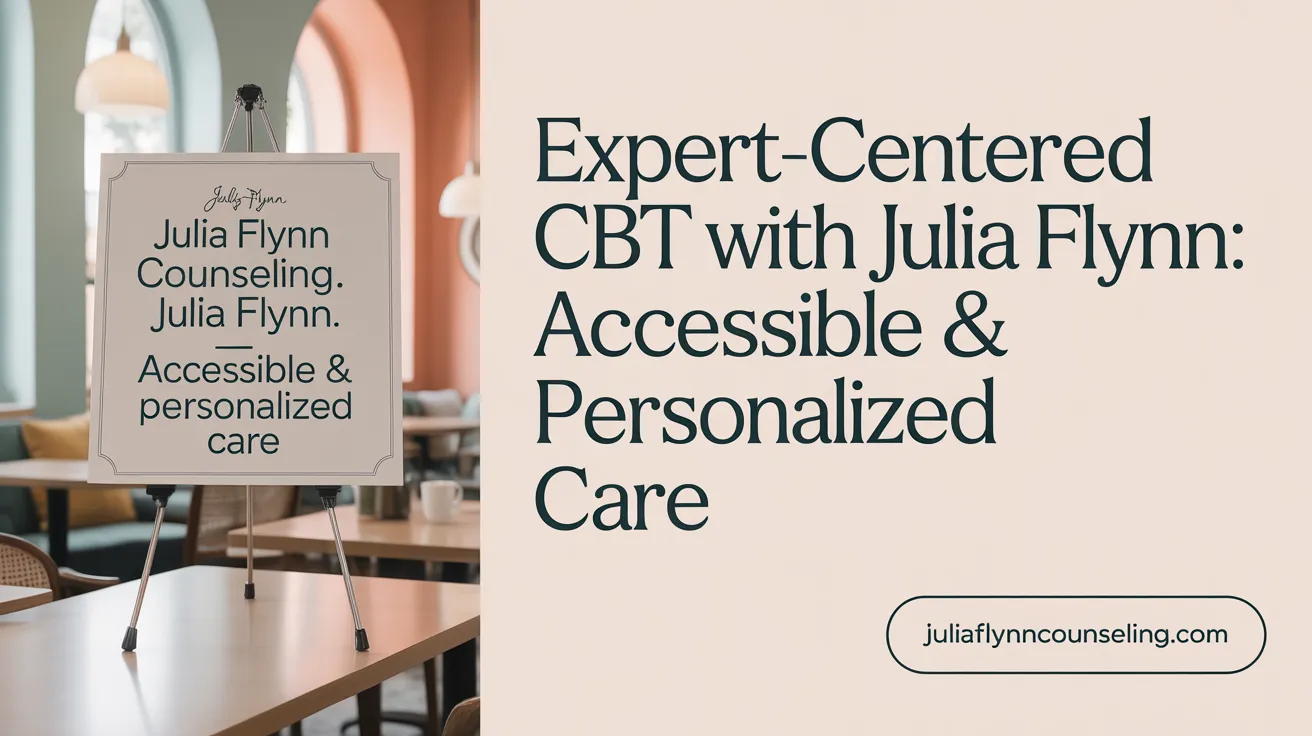Understanding Cognitive Behavioral Therapy (CBT): A Foundation
What is CBT?
Cognitive Behavioral Therapy (CBT) is a structured talk therapy designed to help individuals manage mental health conditions by changing negative thought patterns and behaviors. It focuses on the connection between thoughts, feelings, and actions to promote healthier coping strategies.
Core Principles of CBT
CBT is based on the understanding that psychological issues partly arise from unhelpful thinking patterns, learned behaviors, and core beliefs. By recognizing and challenging these elements, individuals can develop more positive thought and behavior habits.
Conditions Treated with CBT
CBT effectively addresses a range of mental health challenges including depression, anxiety, obsessive-compulsive disorder (OCD), post-traumatic stress disorder (PTSD), phobias, substance use disorders, eating disorders, and ADHD. It can also assist with managing stress, chronic pain, and some physical health conditions.
Overview of Therapy Structure and Duration
Typically, CBT involves 5 to 20 sessions, often weekly, with each session lasting about an hour. The therapy is goal-oriented and time-limited, focusing on current issues rather than past causes. Therapists guide clients in identifying troubling thoughts and behaviors and work collaboratively to implement positive changes through active participation and homework assignments.
The Fundamentals of Cognitive Behavioral Therapy

What is cognitive behavioral therapy?
Cognitive Behavioral Therapy (CBT) overview is a structured, goal-oriented form of psychotherapy that focuses on the close interrelation of thoughts, emotions, and behaviors. It is designed to help individuals recognize and change unhelpful patterns of thinking and learned behaviors that contribute to mental health challenges.
Interrelation of thoughts, emotions, and behaviors
CBT operates on the principle that thoughts, feelings, and behaviors are deeply connected. Negative or distorted thoughts can lead to emotional distress and maladaptive behaviors. By becoming aware of these patterns, clients learn to challenge and modify their thoughts, which in turn influences their emotions and actions positively. See thinking patterns awareness.
CBT as a structured, goal-oriented therapy
CBT is typically delivered in a structured format, emphasizing collaboration between therapist and client. It involves setting clear, achievable goals to address current problems rather than focusing extensively on past experiences. Therapy usually involves 5 to 20 sessions, each with specific objectives and homework assignments to reinforce new skills. Learn more about CBT treatment process.
How faulty thinking and learned behaviors affect mental health
Psychological issues often stem from faulty thinking—such as overgeneralizing or catastrophic thinking—and learned unhelpful behaviors. CBT aims to uncover these cognitive distortions and behavioral patterns so individuals can develop healthier ways to respond to stressors and challenges. Explore faulty thinking and behavior in CBT.
Short-term therapy approach and goal setting
CBT is typically short-term, with progress measured against defined goals. This approach makes therapy manageable and focused, empowering individuals to build practical coping skills quickly. The therapy’s emphasis on present difficulties and active client participation fosters meaningful change within a limited timeframe. Further details at CBT short-term therapy approach.
Key Techniques Employed in CBT Sessions

What are the main CBT techniques?
Cognitive Behavioral Therapy (CBT) employs several core techniques designed to help individuals reshape unhelpful thoughts and behaviors effectively. Learn more in the CBT overview.
Cognitive restructuring and reframing
This technique involves identifying negative, distorted thought patterns—often called cognitive distortions—and actively challenging and reframing them into more balanced, realistic thoughts. By recognizing inaccurate beliefs such as catastrophizing or overgeneralization, clients can reduce emotional distress and develop healthier perspectives. See cognitive restructuring and reframing, cognitive restructuring and reframing, cognitive restructuring and reframing, cognitive restructuring and reframing, and CBT core principles.
Exposure therapy and systematic desensitization
Exposure therapy encourages gradual, controlled confrontation with feared situations or stimuli, reducing avoidance behaviors and anxiety over time. Systematic desensitization pairs this exposure with relaxation techniques to make the process manageable and effective, widely used for anxiety disorders, PTSD, and phobias. Discover more about Exposure Therapy and Cognitive-behavioral therapy for anxiety.
Mindfulness and cognitive defusion
Mindfulness practices help clients focus on the present moment, disengaging from negative rumination. Cognitive defusion—often part of Acceptance and Commitment Therapy (ACT)—teaches individuals to view thoughts as temporary mental events rather than facts, aiding in reducing their emotional impact. Explore Mindfulness in CBT and related positive psychology tools.
Problem-solving and behavioral experiments
CBT assists clients in breaking down complex challenges into smaller, manageable parts and testing new behaviors or beliefs in real-life situations. Behavioral experiments help verify or disprove unhelpful thoughts, promoting adaptive coping and confidence. Further information is available in CBT problem-solving techniques and Cognitive Behavioral Therapy tools.
Journaling and activity scheduling
Journaling or thought recording encourages self-monitoring of thoughts and emotions, supporting increased awareness and insight. Activity scheduling involves planning and engaging in positive or rewarding activities, effectively combating inactivity and low mood, especially in depression. Find out more about Journaling and thought records and Activity scheduling in CBT.
Together, these techniques form a flexible toolbox that therapists tailor to individual needs, making CBT a practical and evidence-based approach to mental health and well-being improvement. For comprehensive understanding, visit What is Cognitive Behavioral Therapy? and CBT Overview by Mayo Clinic.
How CBT Benefits Mental Health and Well-Being
What are the benefits of CBT?
Cognitive Behavioral Therapy (CBT) is widely recognized for its effectiveness in treating a diverse range of mental health conditions such as depression, anxiety, post-traumatic stress disorder (PTSD), obsessive-compulsive disorder (OCD), eating disorders, substance use disorders, and schizophrenia. By identifying and challenging negative thought patterns, CBT helps individuals develop healthier emotional responses and behaviors.
Enhancing emotional regulation and problem-solving skills
CBT promotes emotional regulation by teaching individuals to recognize unhelpful thoughts and manage their emotional responses more effectively. It also enhances problem-solving skills by helping clients break down complex issues into manageable parts and develop practical strategies to address them. This empowerment supports better coping with stress and adversity, as described in CBT techniques for coping strategies.
Improving self-esteem and interpersonal relationships
A significant benefit of CBT is its ability to boost self-esteem. By challenging critical self-talk and negative beliefs, individuals foster a more positive self-view. CBT also improves interpersonal relationships by refining communication skills and encouraging healthier ways of relating to others, as detailed in CBT benefits for mental health.
Promoting long-term coping strategies and resilience
CBT is a skill-building therapy that equips clients with techniques to handle future challenges independently. Through guided exercises and homework, clients learn to respond constructively to stressful situations, promoting resilience and sustained mental well-being. The long-term application of these coping strategies often results in improved quality of life, as explained in CBT process and benefits.
The Therapeutic Process: What to Expect in CBT
Initial assessment and goal setting
CBT begins with an initial session where the therapist collects detailed information about the client's concerns and health history. Together, they discuss therapy goals and develop a personalized treatment plan. This phase is crucial for clarifying what the client hopes to achieve and tailoring the approach to their needs. Learn more about the initial CBT assessment and goal setting.
Collaboration between client and therapist
A hallmark of CBT is the collaborative relationship between the therapist and client. Therapy sessions involve open dialogue to explore thoughts, feelings, and behaviors, identifying unhelpful patterns and how these influence one another. The therapist guides the client to understand and challenge these patterns. See CBT core principles and therapist collaboration.
Homework and skill practice
Clients are encouraged to engage in homework assignments that reinforce skills learned during sessions, such as journaling thoughts, practicing relaxation techniques, or exposure exercises. This active participation outside of therapy helps consolidate progress and fosters self-management. Find CBT techniques and homework assignments.
Duration and session structure
CBT is typically a short-term therapy, often spanning 5 to 20 weekly sessions lasting about one hour each. Initial sessions focus on information gathering and goal setting, while later sessions involve skill-building exercises, cognitive restructuring and reframing, and behavioral changes. More details on CBT session structure and duration.
Managing discomfort during therapy
Facing difficult thoughts and emotions in CBT can cause temporary distress or discomfort. Therapists support clients through these challenges by providing a safe and supportive environment, discussing any distress openly, and adjusting treatment as needed to ensure safety and progress. Learn about managing challenges during CBT therapy.
CBT sessions revolve around understanding troubling issues, raising awareness of thoughts and emotions, recognizing maladaptive patterns, and actively working on changing them to improve coping and well-being. For an overview of how CBT works, see this resource.
Tailoring CBT: Adaptations for Diverse Conditions and Clients

How is CBT adapted for different individuals and conditions?
Cognitive Behavioral Therapy (CBT) is a versatile and customizable treatment that adapts to meet the unique needs of individuals with various mental health challenges. For disorders such as ADHD, bipolar disorder, PTSD, and substance use, CBT protocols are tailored to address distinct symptoms and coping requirements. For example, in substance use and addiction treatment, CBT focuses on raising awareness of triggers, enhancing motivation, and developing healthy coping strategies (American Addiction Centers).
CBT also has specialized forms such as dialectical behavior therapy (DBT) for emotional regulation and acceptance and commitment therapy (ACT) for managing intrusive thoughts, which expand its applicability across differing clinical presentations (Healthline). Children and adolescents can receive CBT designed to fit their developmental stage, often using interactive tools, role plays, and simplified language (Children's Behavioral Health Resources).
Importantly, CBT can be combined with medications and other therapeutic approaches when necessary to improve outcomes, especially in cases of severe or complex conditions (Mayo Clinic). Additionally, cultural and individual adaptations ensure therapy resonates with clients’ values and life contexts, fostering better engagement and effectiveness (Cognitive Behavioral Therapy (CBT) overview).
This flexibility makes CBT an effective treatment option across diverse populations, promoting individualized care focused on present challenges and practical coping skills (Online self-help CBT techniques).
Self-Help and Online CBT: Expanding Access and Tools

What self-help or online CBT options are available?
Online self-help CBT techniques are widely available through online platforms that offer practical tools to improve mental well-being. These techniques include reframing unhelpful thoughts, managing worries, problem-solving, building resilience, facing fears, and maintaining mental health habits. Though these resources are not complete therapy courses, they provide accessible support for individuals seeking to practice CBT principles independently.
Online and virtual CBT programs
In addition to self-help techniques, structured online CBT programs and mobile applications offer more comprehensive treatment options. These digital platforms typically guide users through modules designed to address anxiety, stress, depression, and other common conditions. Internet-delivered CBT extends accessibility for those who cannot attend in-person sessions and can be tailored to individual needs.
Benefits and limitations of self-guided CBT
Self-guided CBT can empower individuals to develop coping strategies and improve emotional regulation at their own pace. It promotes mental health maintenance through easily digestible exercises and helps users recognize and alter harmful thought patterns using cognitive restructuring and reframing. However, it may not be sufficient for everyone, especially those with complex or severe mental health issues who benefit from personalized assessment, guidance, and support from licensed therapists. For more about the benefits of Cognitive Behavioral Therapy (CBT) and when professional help is advised, see related resources.
Role of technology in CBT advancement
Technology has played a significant role in advancing CBT by creating platforms that deliver therapy remotely, increasing its reach and flexibility. Innovations like internet-delivered CBT, virtual reality-based exposure therapy, and smartphone apps provide interactive, evidence-based interventions. This integration enhances user engagement and helps overcome barriers such as geographic distance and stigma, broadening the availability of effective mental health care.
CBT in the Treatment of Anxiety and Stress Disorders
How is CBT used to treat anxiety and stress-related disorders?
Cognitive Behavioral Therapy (CBT) overview is a highly effective, evidence-based treatment widely recognized as the first-line approach for anxiety and stress disorders.
CBT as first-line treatment for anxiety disorders
CBT targets maladaptive thoughts and behaviors that maintain anxiety symptoms. By focusing on the interconnectedness of thoughts, feelings, and behaviors, CBT helps individuals recognize and reframe irrational fears and unhelpful beliefs.
Use of cognitive restructuring and reframing and exposure therapies
Two foundational techniques used in CBT for anxiety are cognitive restructuring and reframing and exposure therapy. Cognitive restructuring involves identifying and challenging distorted thinking patterns—such as catastrophizing or overgeneralizing—to develop more balanced perspectives. Exposure therapy systematically and gradually confronts feared situations or stimuli, helping individuals reduce avoidance and anxiety responses.
Approaches for panic disorder, social anxiety, OCD, PTSD
CBT is tailored to specific anxiety-related conditions. For panic disorder, CBT addresses catastrophic misinterpretation of physical symptoms and includes interoceptive and situational exposures. In social anxiety disorder, exposure to feared social scenarios and cognitive restructuring alleviate negative self-beliefs. For OCD, exposure and response prevention tackles compulsive rituals by confronting obsessional triggers without performing rituals. CBT for PTSD combines restructuring maladaptive trauma-related beliefs with exposure to trauma memories and reminders, facilitating recovery. (More on CBT for anxiety-related disorders)
Combining CBT with pharmacotherapy
CBT can be effectively combined with medications like SSRIs, enhancing treatment response. However, pharmacotherapy may sometimes diminish the effectiveness of exposure-based elements, requiring careful coordination by clinicians. (CBT and medication
Innovations like virtual reality exposure
Emerging methods such as internet-delivered CBT make therapy more accessible by providing remote, structured programs. Virtual reality exposure therapy immerses patients in simulated environments to replicate feared stimuli, allowing safe and controlled anxiety reduction exercises.
Overall, CBT offers a flexible and scientifically supported path to manage anxiety and stress, empowering individuals with practical skills and long-lasting coping mechanisms. (Overview of CBT for anxiety and stress
Why Choose Julia Flynn Counseling for CBT?

Who is Julia Flynn and what does her practice offer?
Julia Flynn is a licensed clinical mental health counselor with over 22 years of professional experience. She is licensed in multiple states including Florida, California, Kansas, and Missouri. Specializing in evidence-based treatments, Julia focuses on cognitive behavioral therapy (CBT) to support clients dealing with depression, anxiety, and substance use disorders.
Licensed and experienced mental health professional
Julia's extensive training and licensure ensure that clients receive expert guidance. With a solid clinical background, she brings effective therapeutic approaches to each personalized treatment plan.
Specialization in depression, anxiety, substance use disorders
Her expertise includes managing some of the most challenging mental health conditions. By focusing on these areas, Julia provides targeted CBT methods proven by research to improve client outcomes.
Individualized treatment planning with evidence-based CBT
Clients collaborate with Julia to establish goals and tailored therapy plans. This client-centered approach uses CBT techniques to help unlearn negative patterns and develop healthier thoughts and behaviors.
Flexible online therapy sessions
The practice offers secure, HIPAA-compliant online therapy, allowing clients to attend sessions comfortably and privately from their own devices. This flexibility supports ongoing engagement, especially when in-person visits are difficult.
Insurance and accessibility options
Julia Flynn Counseling accepts a range of insurance plans including Medicare, TRICARE, UnitedHealthcare, and out-of-network options. Transparent upfront payment with receipts makes therapy more accessible to a broader population. For more information, see insurance and payment options in CBT therapy.
Embracing CBT for Lasting Mental Health Improvement
Transforming Lives Through Cognitive Behavioral Therapy
Cognitive Behavioral Therapy (CBT) is a powerful and structured approach to managing a wide range of mental health conditions such as depression, anxiety, PTSD, and substance use disorders. It works by uncovering and reshaping unhelpful thought patterns and behaviors, allowing individuals to develop healthier responses to challenges. This therapy fosters self-awareness and equips clients with practical coping skills that promote emotional well-being and resilience over time.
The Role of Active Participation
For CBT to be effective, active engagement from the individual is essential. Success often depends on openness in sessions, honest communication, and commitment to homework and practice outside therapy. This collaborative effort between therapist and client ensures therapeutic goals are met and new habits can be firmly established.
Seeking Tailored Treatment for Best Outcomes
Each person's experience and needs are unique; therefore, personalized CBT treatment plans are crucial. Working with a licensed mental health professional ensures approaches are adapted appropriately to individual concerns, whether through face-to-face, online, or group sessions. If you're considering CBT, reaching out for a professional assessment can be an empowering first step towards lasting mental health improvement and a more fulfilling quality of life.
